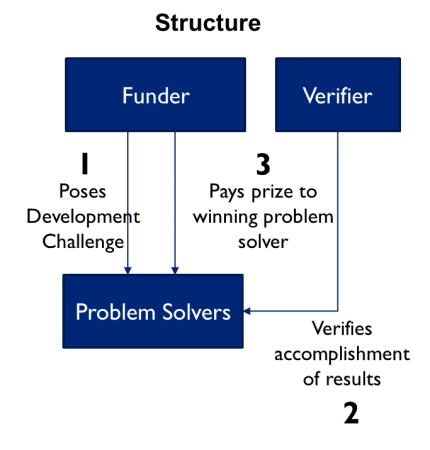4.5.12. Pay for Results: Prizes
DESCRIPTION
An arrangement where prizes (financial rewards) are awarded, usually through an open and competitive process, to one or more competitors that are successful at accomplishing a pre-specified desired result (which could be a fresh approach to a development challenge). Prize competitions mobilize a range of participants to try to achieve a desired result and select winners based on assessment of evidence of their achievements, rather than pre-selecting a single implementer.
CONSTRAINTS ADDRESSED
- Appropriate capital to meet borrower needs
- Production costs associated with target sector/region
- Rate of return on lending in target sector/region
ADVANTAGES
Contests incentivize innovative approaches to development challenges by encouraging many groups to solve the problem; helps to raise awareness of difficult development challenges, while engaging a larger universe of problem solvers (incl. non-traditional partners); can complement traditional grant programs by addressing some of their limitations, expands number of problem solvers by reducing barriers to entry.
DISADVANTAGES
Image

Designing successful prizes can be complicated, as determining prize amounts and measuring success are complex. Challenges from the designer side include: Only a few winners with the time and resources to take the needed action to achieve results ultimately receive funding; other problem solvers with great ideas (but without deep pockets to fund their participation) may be excluded; Defining the proper metrics for measuring success upon which prizes are awarded, and ensuring fairness in the evaluation process; Finding capable participants and communicating the opportunity to them (often need non-traditional channels); Determining cost-effective testing or assessment procedures to determine winner/s and finding qualified judges in the subject area. From the applicant side: Funding rewards are often small, and often out of proportion with the risk of participating; Chances of winning are low and difficult to calculate, so cost/benefit of applying is unknown; Feedback on losing applications can be minimal, so often not a learning opportunity; Attendant publicity of winning often does not lead to “bigger things”.
MUST HAVE’S, CRITICAL POINTS, OR QUESTIONS TO CONSIDER
Prizes are most appropriate when designed to address specific issues that require innovative methods and have no widely accepted solutions; designers/funders want to increase the number of people working on a problem; there are clear and measurable outcomes against which to make; the available funding for prizes is significant enough to attract capable and diverse problem solvers. Note that it is important to develop a clear plan for how to sustain results after the prize or connect efforts to a broader program.
VIGNETTE: AGRESULTS ON-FARM STORAGE PRIZE (KENYA)
SITUATION
AgResults uses pay for results to incentivize the scaling of high impact agricultural innovations. AgResults uses prizes to incentivize the private sector to enter markets they would usually deem unattractive by reducing barriers to entry.
STRUCTURE
The Kenya On-Farm Storage project aims to build a market for improved on-farm storage and reduced post- harvest losses of maize. Post-harvest grain losses in the developing world lead to lower incomes and food insecurity among smallholder farmers. While private sector solutions to post-harvest losses exist, they are often too expensive or not accessible to smallholder farmers across the developing world. Over $6.25 million in prizes were awarded to storage device manufacturers that sold enough metric tons of storage to trigger prize thresholds.
IMPACT
Competing for this prize helped de-risk upfront marketing and distribution costs incurred by storage device manufacturers and promoted improved on-farm storage practices.

